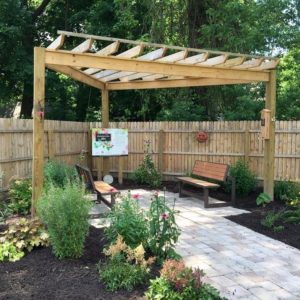Get Involved
NCST’s work increases access to homeownership, promotes resilient neighborhoods, and advances racial equity by advocating for policy change.
By Chris Garland, Community Development Manager
While much of our work at NCST focuses on the approaches that our community partners throughout the county employ to rehabilitate vacant homes, we shouldn’t lose sight of the crucial importance of activating vacant land. With that thought, I’d like to introduce you to our long-time partner in the Warren, Ohio area, the Trumbull County Land Bank.
Established in 2010, the Trumbull County Land Bank partners with the Trumbull Neighborhood Partnership (TNP), an independent non-profit, whereby TNP manages the sale, transfer, disposition, demolition, rehabilitation, and reutilization of all Land Bank owned property. Over the last decade following considerable investments in residential demolition, the Trumbull County Land Bank in partnership with TNP has implemented creative reuses for vacant lots throughout the city, including demolition candidates acquired through NCST.
manages the sale, transfer, disposition, demolition, rehabilitation, and reutilization of all Land Bank owned property. Over the last decade following considerable investments in residential demolition, the Trumbull County Land Bank in partnership with TNP has implemented creative reuses for vacant lots throughout the city, including demolition candidates acquired through NCST.
According to Shawn Carvin, Land Bank Director, an early area of focus was a historic neighborhood adjacent to downtown Warren which until resident intervention had been known locally as “Area 51”. This area has more recently been dubbed “the Garden District”, as the neighborhood is now home to a variety of greening projects including community spaces, wildflower lots and community gardens.
The Land Bank and TNP helped to establish approximately 18 community gardens between 2012 to 2020, (following NSP1-, NSP2- and NSP3-funded demolitions). Today, many of those gardens host produce stands, and some sell their harvests at the Warren Farmers Market.

Through its Lots of Love program, the Land Bank invites residents and community groups to propose project ideas for vacant lots. The Land Bank provides the initial installation of a greening project on a vacant lot where the applicant(s) have committed to maintaining the lot for the foreseeable future. As Shawn Carvin puts it, “there’s a timeline to these projects, and it’s as long as the resident and neighborhood remain interested.” The Lots of Love program is “targeted at community projects that will provide public space and are selected based on clarity and feasibility of the project idea and community support for the project.”
In order to complete the initial installation of these projects, the Land Bank was able to utilize a dedicated source of land reuse funding that was made available in Ohio’s Neighborhood Initiative Program/Hardest Hit Fund (HHF) as other sources of demolition funding typically do not support post-demolition land reuse. For each of the project sites, the Land Bank maintains ownership and TNP provides technical support to the Lots of Love community groups including grant writing assistance and quarterly site inspections.
In addition to raised bed gardens and a cut-through pathway, some intriguing examples of projects include a reflective labyrinth, a veteran’s memorial and a children’s garden. Additionally, a series of basketball hoops have been installed as Lots of Love projects. As Shawn Carvin explains, residents had become frustrated with guerilla style basketball hoops being set up on neighborhood streets, raising driving traffic safety concerns. So as an experiment, the Land Bank agreed to pave a targeted street corner vacant lot and install a basketball hoop. The addition was well-received, and since then additional basketball projects have been completed in other areas where residents requested them.
Like many other communities, the Land Bank offers vacant lots to area residents as side yards. In fact, the Land Bank transfers 100-150 side yard lots annually. The Land Bank also utilizes the land reuse allocation from HHF to provide up to $1,500 of landscape services such as plantings and fencing for eligible parcels. Huntington Bank also supports side yard recipients in low/mod census tracts providing a $200 Lowes Gift Card which Lowes matches with an added 10% discount.
 In looking forward, Shawn Carvin views a future Warren, Ohio filled with creative art installations. A first example in this “Land Art Generator” is a 25 foot tall sculpture featuring material from residential demolitions completed by area artist, Doug Meyer.
In looking forward, Shawn Carvin views a future Warren, Ohio filled with creative art installations. A first example in this “Land Art Generator” is a 25 foot tall sculpture featuring material from residential demolitions completed by area artist, Doug Meyer.
Looking forward to 2021, NCST is excited to see how we can continue to support your communities and your creative approaches to neighborhood stabilization.
For Media Inquiries:
Please reach out to the following NCST staff for comments on housing policy:
Carlos Alcazar, Chief Operations Officer
calcazar@ncst.org
Stay current on all the news from NCST about housing policy, affordable homeownership, and new programs that highlight how homeownership could close the racial wealth gap. Sign up for the NCST monthly newsletter today.
NCST’s work increases access to homeownership, promotes resilient neighborhoods, and advances racial equity by advocating for policy change.